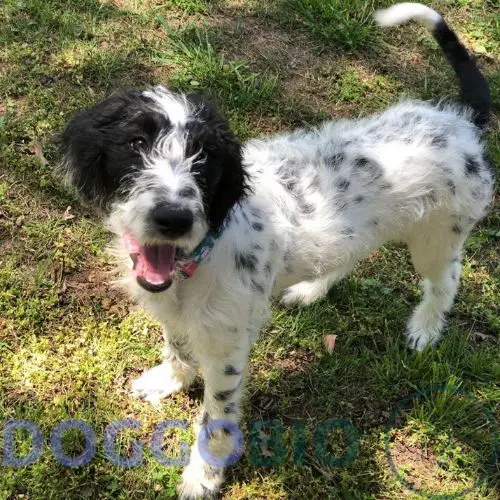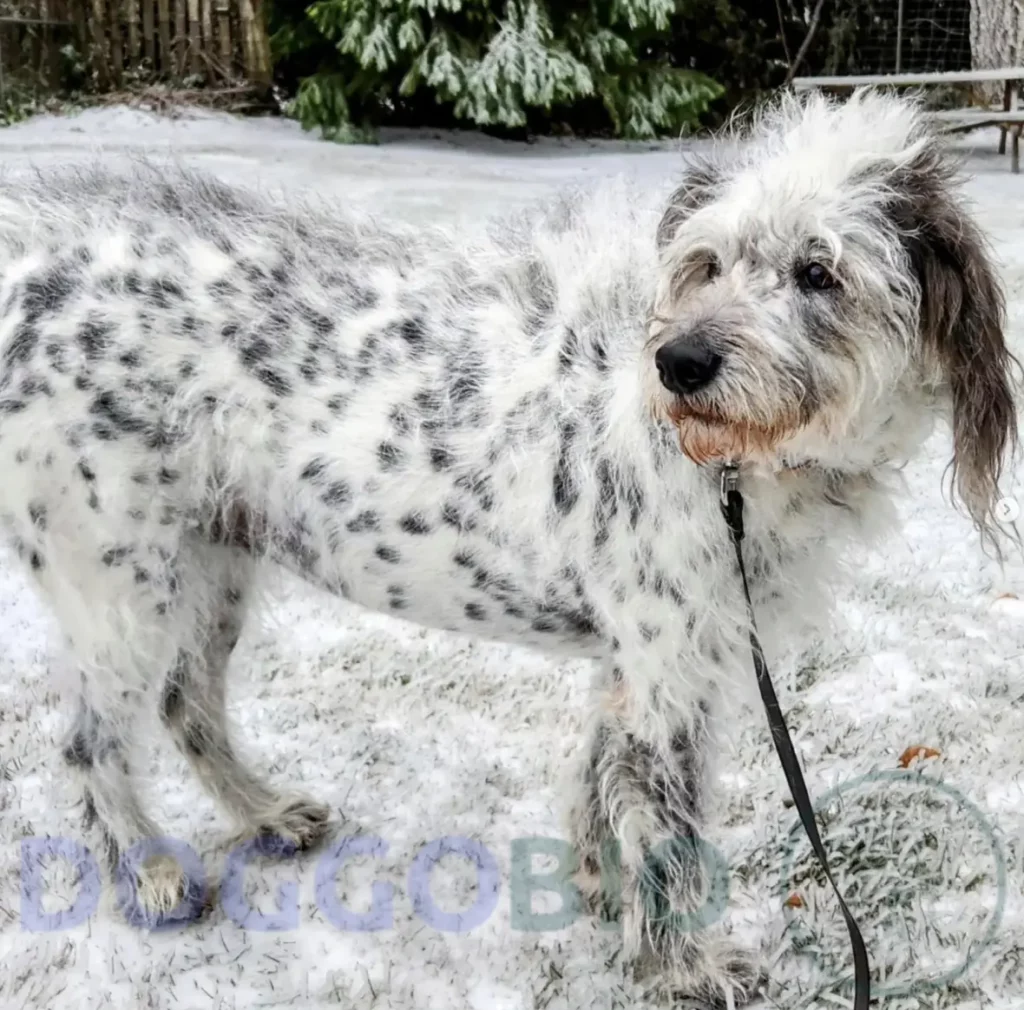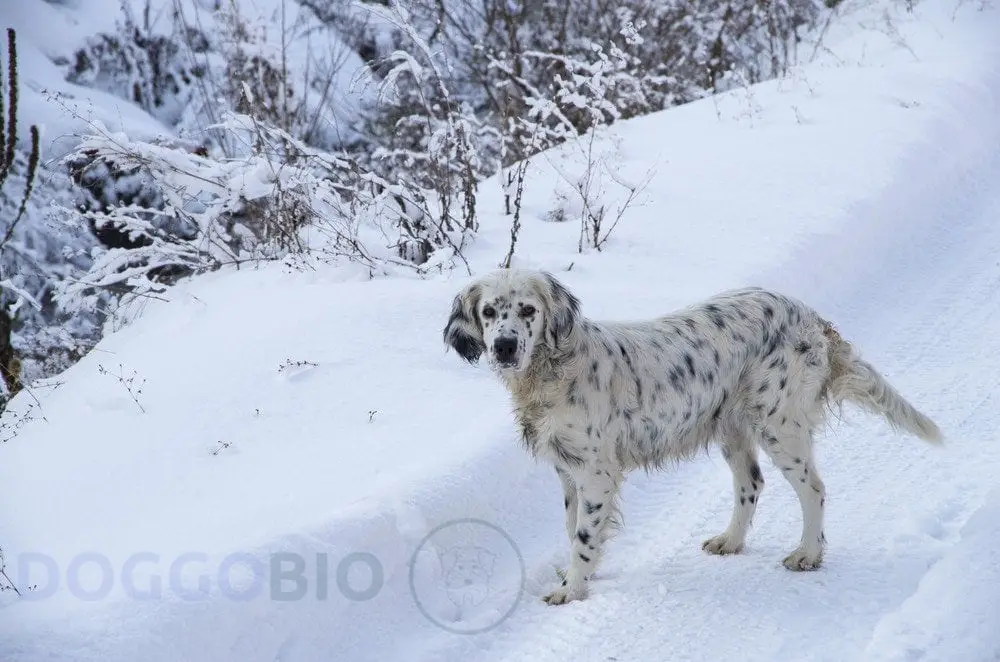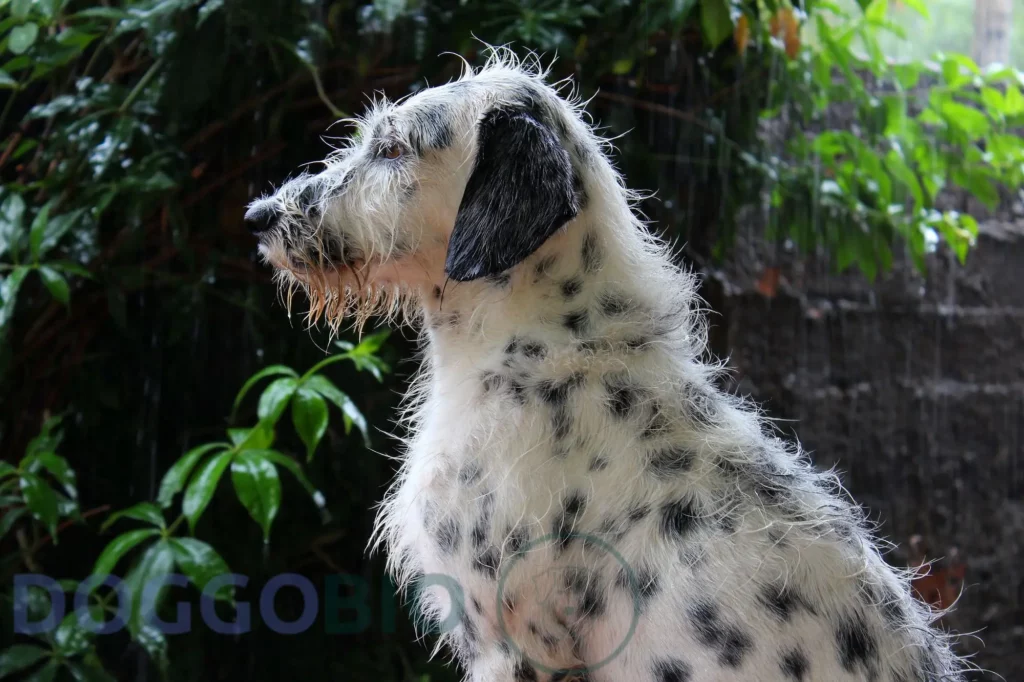The Dalmatian Poodle Mix, also known as the Dalmadoodle, is a mixed breed dog that results from crossing a Dalmatian with a Poodle. This unique hybrid breed is gaining popularity among dog lovers due to its charming appearance and friendly temperament.
With the Dalmatian’s distinctive spotted coat and the Poodle’s curly, hypoallergenic fur, the Dalmadoodle has a striking and eye-catching appearance. As a crossbreed, Dalmadoodles can exhibit various physical and personality traits, making each dog unique.
In this article, we will explore the origins, characteristics, and care requirements of the Dalmatian Poodle Mix to help you decide if this hybrid breed is the right fit for you and your family.
A Brief Overview of Dalmatian Poodle Mix
| Other Names | Dalmapoodle, Dalmatian Doodles |
| Breed Group | Crossbreed |
| Size | Large |
| Weight Range | 40-70 pounds |
| Height Range | 15-24 inches |
| Coat Colors | Black, White, Apricot, Cream Silver, Sable, Brown |
| Purpose | Companion dog |
| AKC Recognition | No |
| Temperament | Friendly, Playful, Energetic |
| Lifespan | 11-14 years |
| Average Puppy Cost | $800 upwards |
What is a Dalmatian Poodle Mix?

The Dalmatian Poodle Mix, also known as Dalmadoodle or Dalmapoodle, is real! This designer breed is a result of crossing a Dalmatian with a Poodle, resulting in a fantastic fusion of the best traits from each parent.
The Dalmadoodle is a brilliant and devoted dog that can grow into one of the larger Poodle mixes. These dogs can be great for families looking for loving and loyal companions.
If you’re thinking of getting a Dalmatian Poodle Mix, remember to research well and find a reputable breeder to ensure the health and well-being of your new furry friend.
Parent Breeds of Dalmatian Poodle Mix
To better understand the Dalmadoodle, it’s essential to delve into its parent breeds’ history, appearance, and temperament.
Origins and History of Dalmatians

By the 19th century, Dalmatians had garnered a reputation for themselves in the region of Dalmatia, a geographical area in central Europe near the illustrious Adriatic Sea. The breed acquired its name in this area, a title that would go down in history as a testament to its magnificent lineage.
Dalmatians have always been considered some of the most versatile working dogs, with a storied past that includes various roles. From their humble beginnings as shepherds to their time spent as retrievers, bird dogs, and even circus performers, Dalmatians have always been the dogs that could do it all. But the most iconic role of the Dalmatian was that of coach dog – a position of great responsibility.
As coach dogs, Dalmatians ran alongside horse-drawn carriages, constantly vigilant and ready to protect their masters’ vehicles. This was no easy feat, as Dalmatians had to be lightning-quick and capable of keeping up with the pace of the horse-drawn carriage. But they did not stop there.
In the 1800s, horses pulled fire engines, and it was during this time Dalmatians became inextricably linked to firefighters. The American Kennel Club took notice of the breed’s potential. It began recognizing the Dalmatian in 1888, forever cementing its place in history as one of the most iconic dog breeds in the world.
Origins and History of Poodle

The history of the Poodle breed is an intriguing story that defies conventional wisdom. Although widely associated with the French, it was, in fact, Germany that first saw the emergence of these magnificent canines over four centuries ago. In German, “puddling” refers to the dogs’ splashing in the water as they retrieved waterfowl. This activity would eventually lead to their iconic status as duck hunters.
Poodles soon became renowned as the ultimate retrievers with their curly, weatherproof coats, natural swimming ability, and unparalleled intelligence. Their versatility was evident as they transitioned from the lake to the life of luxury, becoming the breed of choice for French nobles and, eventually, royalty across Europe. Today, the Poodle remains the national dog of France, a testament to their regal lineage.
The Poodle’s allure did not stop there. Their showy looks, intelligence, and ease of trainability made them a prominent feature in circus acts worldwide, solidifying their place in popular culture.
As the breed continued to evolve, the miniature and toy variations of the Poodle were bred, each with unique characteristics. The Toy Poodle was first introduced in the United States during the early 20th century as the ultimate city-dwelling companion dog. The breed’s many positive personality traits and hypoallergenic coat make it a popular choice to this day.
Today, Poodles are commonly bred with a wide variety of other breeds to produce the “designer” hybrid dogs known and loved by many as “doodles.” The Poodle’s rich history and versatile nature ensure it will remain a beloved breed for generations.
Interesting Facts about Dalmatian Poodle Mix

1. Dalmadoodles can’t handle the heat!
While they may thrive in the cold, these dogs can suffer in high temperatures. Keep a watchful eye on your pup when playing outdoors during the summer months, and if they start panting heavily, it’s time to take a break.
But don’t worry, Dalmadoodles typically love water, so a quick hose down or a dip in the pool can help them cool off. Just be mindful of the temperature of the water – you don’t want it to be too cold or too warm!
2. They like having a job
These pups were bred to work hard and will be happiest when they have a task to complete. Dalmatians are known for trotting alongside horse-drawn carriages and serving as firehouse mascots. Meanwhile, Poodles were bred to retrieve waterfowl.
So, when you mix these two breeds, you get a dog that craves a purpose. Give your Dalmadoodle a job to do, and they’ll be over the moon with joy.
Whether fetching the newspaper or helping with chores, your pup will thrive when they feel they’re contributing.
3. Dalmadoodles aren’t suitable for living in apartments
These dogs have tons of energy and love to be active, so they’re not the best fit for apartment living. They need plenty of space to run around and play, so a big backyard or a nearby dog park is necessary.
These pups might become anxious and destructive without enough room to stretch their legs. You don’t want that! Keeping them engaged and stimulated is essential so they don’t get bored and start causing trouble. So, if you’re considering getting a Dalmadoodle, ensure you have the right living situation for them.
What Does a Dalmatian Poodle Mix Look Like?
The physical appearance of a Dalmatian Poodle Mix, also known as Dalmadoodle, can be unpredictable and varied. Some may inherit more of the Poodle’s curly coat, while others may have the Dalmatian’s short, smooth coat. The famous black spots on a Dalmatian may appear in some Dalmadoodles, while others may not have them at all.
The body of a Dalmadoodle is athletic and sturdy, with long, slender legs that make them agile and speedy. Their tails are also long and thin, adding to their graceful appearance. Their eyes are usually oval-shaped and can come in various colors, from brown to blue to hazel. The ears are floppy and long and wide, just like the Dalmatian’s.
In short, Dalmatian Poodle Mix is a unique and unpredictable breed regarding physical appearance, but one thing is for sure – they are always beautiful in their way.
Size, height, and weight
On average, Dalmadoodles stand at an impressive 21-23 inches at the shoulder and generally weigh between 45-70 pounds for males and between 40-60 pounds for females. However, these numbers are only a rough approximation, as there are several factors to consider regarding this canine’s dimensions.
Dalmatians can be bred with various poodles, from toy to miniature to standard. Still, the miniature and standard varieties are the most common choices. The size of the Poodle that the Dalmatian has bred with plays a critical role in determining the Dalmadoodle’s final measurements.
Coat colors and types
The Dalmapoodle, a Dalmatian Poodle Mix, sports a diverse coat that comes in waves, curls, or straight strands, sometimes within the same litter, and ranges from short to medium length.
Typically white with unique black spots, these dogs can also exhibit minimal or no markings. Thanks to their Poodle heritage, they may also flaunt a spectrum of colors like apricot, cream, black, silver, sable, or brown, with their distinctive spots varying from black to liver, showcasing the breed’s rich variety.
Temperament and Personality
The Dalmadoodle is no ordinary dog — it’s the fusion of two of the most intelligent breeds, Poodles and Dalmatians. This combination results in a brilliant and wise pup that can learn anything quickly and even discover things you don’t want them to find.
They can be escape artists; you better hide your treats because they will find them instantly. But wait, there’s more! They also tend to inherit the Dalmatian’s stubborn nature, which can create a training nightmare when combined with their brainpower. It would help if you kept on top of their training.
However, the Dalmatian Poodle Mix isn’t bad; it can be loving and affectionate. You can rest easy knowing that aggression problems are rare, but watch out for resource-guarding issues. If they don’t get enough physical and mental stimulation daily, they will find other ways to occupy themselves, such as shredding their shoes and digging holes in their lawn.
Is Dalmatian Poodle Mix a good fit for families?
These dogs are top-notch when it comes to being family pets. They have an excellent reputation for being especially good with children, so you can feel confident bringing them home to your little ones.
They’re also fiercely protective of their human siblings, so think twice before introducing them to any new folks when they’re around your kids. It takes some time for them to warm up to strangers, but if the person can pass their test, they’ll soon become fast friends.
If you have a big family, these dogs will fit right in! They’re tireless and always on the go, so the more family members you have to keep up with, the better. Remember to divide the exercise between everyone so no one gets burnt out.
Training

The Dalmatian Poodle Mix is a quick study, so you can expect them to pick up on any tricks you teach them quickly. Whether you enjoy one-on-one sessions or group classes, they’ll do well in both settings.
Socialization is critical for these pups, as they can only be wary of strangers if they’re used to meeting new people. Give them plenty of opportunities to socialize with other dogs and new situations.
As for training methods, positive reinforcement is the way to go. Punishing them is a big no-no, as they’re sensitive dogs that could become skittish or even rebellious if they feel like they’re being mistreated.
And remember mental stimulation, as they have a lot of energy to burn. Puzzle toys, interactive games, and obedience drills are great ways to challenge their minds and prevent them from becoming bored or destructive.
Exercise Requirements
If you’re considering adding a Dalmadoodle to your family, be prepared for some serious activity!
- These pups have lots of energy to burn, so you’ll need to ensure they get plenty of exercise each day. Dalmatians and Poodles love to play, so you must be ready to keep up with them.
- To keep your Dalmatian Poodle Mix from getting bored and destructive, plan on giving them at least 90 minutes of exercise each day. This can include walks, hikes, runs, or games of fetch. A big, fenced-in yard would be ideal for letting your pup run around and burn off some steam. And if you have a dog door, even better!
- But exercise isn’t the only thing your Dalmadoodle needs. These pups are also brilliant and need mental stimulation to stay happy and healthy. So be sure to provide plenty of toys, puzzles, and other activities to keep their minds engaged. Your Dalmadoodle will be one happy pup with enough exercise and mental stimulation!
Living Conditions
Dalmadoodles are friendly creatures that crave human attention and affection, and being left alone outside for extended periods can spell disaster for their mental and physical well-being.
If you need to keep your dog confined temporarily, crate training is an option that can provide a safe and secure environment. But if your furry friend needs to live outdoors, provide a well-insulated shelter that can protect it from the elements.
Although they may be small in stature, Dalmatian Poodle Mixes are not apartment-friendly pets due to their high energy levels and need for plenty of space to move around. A house with a spacious yard is a much better environment for them to thrive and be happy.
Grooming and Cleaning
Grooming these furry friends can be a mixed bag, depending on which parent breed they take after more.
If they take more after the Dalmatian, you won’t need to groom them as frequently, but you should still give them a good weekly brushing with a wire brush and maybe even a good once-over with a vacuum to keep their coat in tip-top shape.
If your Dalmatian Poodle Mix has a longer, softer coat like their Poodle parent, be prepared to do more regular grooming work. You’ll need to brush them every other day or so and may want to schedule a monthly haircut appointment to keep their fur from getting out of control.
Regardless of your Dalmadoodle’s coat, they’ll need their teeth brushed and nails trimmed regularly like any other dog. And remember to clean their ears out regularly to prevent infection.
| Grooming Needs | Grooming Frequency |
| Coat Brushing | 2 to 3 times a week |
| Bathing | Weekly or as needed |
| Teeth Brushing | 3 to 4 times a week |
| Nail Trimming | As needed |
| Ear Cleaning | Check regularly |
| Eye Care | Regularly check and clean as necessary |
| Hair Trimming | As required for specific areas |
Are Dalmatian Poodle Mixes Hypoallergenic?
Yes and no. The hypoallergenic status of a Dalmatian Poodle Mix depends on the inherited coat type.
If the mix has inherited the Poodle’s curly, low-shedding coat, it is more likely to be hypoallergenic, as this type of coat traps dander.
However, if the dog takes after the Dalmatian’s shedding coat, it may not be hypoallergenic.
Food and Diet
When it comes to the diet of a Dalmatian Poodle Mix, it’s essential to provide them with a well-balanced meal split into two servings per day, with a recommended amount of 1.5 to 2 cups. However, the quantity of food given to your furry friend should be based on various factors such as age, size, and activity level.
To spice up your Dalmapoodle’s diet, consider supplementing their meals with fresh fruits and vegetables with the guidance of your trusted veterinarian.
Common Health Issues
Dalmatian Poodle Mix or Dalmadoodle is a relatively healthy breed, but they can still inherit some common health issues from their parents.

1. Deafness
Did you know that approximately 80% of Dalmatians are deaf? As such, a Dalmatian Mix Poodle may also suffer from this hearing disorder.
2. Addison’s Disease
Did you know that Addison’s Disease is a common health issue afflicting a Dalmatian Mix Poodle? This Disease results from the adrenal glands not producing enough corticosteroid hormones. Interestingly, Poodles are one of the breeds commonly affected by this Disease.
3. Hyperadrenocorticism
Cushing’s Disease, also known as hyperadrenocorticism, is a condition where the adrenal glands produce excessive cortisol hormone. This can lead to various health problems, such as kidney damage and diabetes, and it is not uncommon in dogs, including Dalmatian Mix Poodles.
4. Hip Dysplasia
Hip dysplasia is a skeletal condition when the hip joint is improperly formed, leading to discomfort and limited mobility. It is a common health issue among large dog breeds, such as the Dalmatian, and can be painful for affected dogs.
The condition is caused by the misalignment of the ball and socket in the hip joint, which leads to abnormal rubbing and wear on the joint rather than the smooth gliding motion typical of a healthy hip joint.
5.Iris Sphincter Dysplasia
Iris Sphincter Dysplasia is a condition where the iris, the colored part of the eye, does not develop properly due to a genetic abnormality. This eye disease is frequently found in Dalmatian dogs and can lead to vision impairment or blindness.
How Long Does a Dalmatian Poodle Mix Live?
Dalmadoodles’ lifespan is a topic of interest for many potential owners, and it’s worth noting that they typically live for 11 to 14 years.
However, it’s important to remember that many factors can impact a dog’s lifespan, including genetics, environment, and overall health. As with any dog breed, providing proper nutrition, regular exercise, and routine veterinary care can help extend their life expectancy.
How Much is The Price of a Dalmatian Poodle Mix?
The cost of a Dalmadoodle can be unpredictable, as breeders may charge more for certain coat types or colors. On the other hand, you might find one in a shelter if you’re lucky. But if you want to buy one from a reputable breeder, be prepared to shell out around $800.
Is Dalmatian Poodle Mix Right For Me?
Are you thinking of getting a Dalmatian Poodle Mix? The good news is that the Dalmadoodle is an excellent family dog that loves everyone, even other pets in the house.
However, you should be ready to be physically active, as this breed needs an active lifestyle to be happy. If not, your furry friend can get bored and start chewing on random things in the house to keep herself occupied.
List of dogs that are similar to Dalmatian Poodle Mix
- Poodle-French Bulldog Mix
- Poodle-Saint Bernard Mix
- Poodle-German Shepherd Mix
- Poodle-Pitbull Mix
- Poodle-Corgi Mix
- Poodle-Shiba Inu Mix
- Cavapoo
- Dalmatian-Pitbull Mix
- Dalmatian-Husky Mix
- Dalmatian-Corgi Mix
- Long-Haired Dalmatian
Frequently Asked Questions
Do Dalmatian Poodle Mixes Shed A Lot?
No,Dalmatian Poodle Mixes, or Dalmadoodles, may not shed a lot due to the Poodle’s hypoallergenic, low-shedding traits. However, because they are a mixed breed, their shedding can vary.
If the Poodle’s non-shedding traits dominate, the Dalmadoodle may shed minimally. On the other hand, if the Dalmatian’s shedding traits are more pronounced, the dog may shed more.
The exact amount of shedding is unpredictable in mixed breeds like the Dalmadoodle.
Do Dalmatian Poodle Mixes get along with other pets?
Yes, but with considerations. Dalmatian Poodle Mixes, or Dalmadoodles, typically enjoy the company of other dogs, thriving on energetic playmates.
However, their compatibility with cats or smaller pets can be uncertain due to their potential prey drive, inherited from the Poodle’s hunting background.
To foster peaceful cohabitation, it’s important to provide ample exercise, training, and socialization to mitigate their instinctual behaviors.
Conclusion
In conclusion, the Dalmatian Poodle Mix is a fascinating crossbreed dog that combines the best of the Dalmatian and Poodle breeds. With a striking appearance, friendly temperament, and adaptable nature, Dalmadoodles make excellent family pets and companions.
However, before deciding to bring a Dalmatian Poodle Mix into your home, it’s essential to understand their care requirements, training needs, and potential health concerns. You can help your Dalmadoodle thrive and enjoy a happy and healthy life with your family by providing proper training, socialization, and care.

Pingback: Corgi Poodle Mix: Powerful Secrets You Need to Know 2023
Pingback: Corgi Dalmatian Mix: The Ultimate Handbook to The Owner 2023
Pingback: Dalmatian Husky Mix: Interesting Facts You Need to Know 2023
Pingback: Shiba Inu Poodle Mix: All You Need to Know 2023
Pingback: German Shepherd Poodle Mix: Ultimate Handbooks 2023
Pingback: Saint Berdoodle: Unique Characteristics of this Mix 2023
Pingback: French Bulldog Poodle Mix: Delve into the Fascinating World 2023
Pingback: Long-Haired Dalmatian: Majestic Beauty of a Rare Coat 2024
Pingback: Pitbull Poodle Mix: Interesting Facts You Need to Know 2024
Pingback: F1B Cavapoo Charms: Embrace the Perfect Poodle Mix 2024